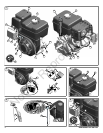
6 BRIGGSandSTRATTON.COM
Features and Controls
Compare the illustration
1
with your engine to familiarize yourself with the location of
various features and controls.
A. Engine Identification
Model Type Code
B. Spark Plug
C. Air Cleaner
D. Choke Control
E. Fuel Shut-off Valve (optional)
F. Starter Cord Handle
G. Finger Guard
H. Throttle Control (optional)
I. Stop Switch (optional)
J. Fuel Tank and Cap
K. Extended Dipstick (optional)
L. Short Dipstick (optional)
M. Oil Drain Plug
N. Oil Fill
O. Muffler
Muffler Guard (optional)
Spark Arrester (optional)
P. Electric Start Switch (electric start models) *
* Equipment may have remote controls. See the equipment manual for location and
operation of remote controls.
Operation
Oil capacity (see the Specifications section)
Oil Recommendations
We recommend the use of Briggs & Stratton Warranty Certified oils for best
performance. Other high-quality detergent oils are acceptable if classified for service SF,
SG, SH, SJ or higher. Do not use special additives.
Outdoor temperatures determine the proper oil viscosity for the engine. Use the chart to
select the best viscosity for the outdoor temperature range expected.
SAE 30
10W-30
Synthetic 5W-30
5W-30
°F °C
* Below 40°F(4°C) the use of SAE 30 will result in hard starting.
** Above 80°F(27°C) the use of 10W-30 may cause increased oil consumption. Check
oil level more frequently.
How To Check/Add Oil - Figure
2 4
Before adding or checking the oil
• Place engine level.
• Clean the oil fill area of any debris.
Models with short dipstick (Figure 2)
1. Remove the dipstick (C) and wipe with a clean cloth.
2. Insert the dipstick but do not screw in. Oil level should be at FULL mark (D).
3. To add oil, pour the oil slowly into the engine oil fill (B). Fill to point of overflowing.
4. Replace and tighten the dipstick.
Models with extended dipstick (Figure 4)
1. Remove the dipstick (A) and wipe with a clean cloth.
2. Insert and tighten the dipstick.
3. Remove the dipstick andcheck the oil level. It should be at the top of the full indicator
(B) on the dipstick.
4. To add oil, pour the oil slowly into the engine oil fill (C). Do not overfill. After adding
oil, wait one minute and then recheck the oil level.
5. Replace and tighten the dipstick.
Fuel Recommendations
Fuel must meet these requirements:
• Clean, fresh, unleaded gasoline.
• A minimum of 87 octane/87 AKI (91 RON). High altitude use, see below.
• Gasoline with up to 10% ethanol(gasohol) or up to 15% MTBE (methyl tertiary
butyl ether) is acceptable.
CAUTION: Do not use unapproved gasolines, s uch as E85. Do not mix oil in gasoline or
modify the engine to run on alternate fuels. This will damagethe engine components and
void the engine warranty.
To protect the fuel system from gum formation, mix a fuel stabilizer into the fuel. See
Storage. All fuel is not the same. If starting or performance problems occur, change fuel
providers or change brands. This engine is certified to operate on gasoline. The
emissions control system for this engine is EM (Engine Modifications).
High Altitude
At altitudes over 5,000 feet (1524 meters), a minimum 85 octane/85 AKI (89 RON)
gasoline is acceptable. To remain emissions compliant, high altitude adjustment is
required. Operation without this adjustment will cause decreased performance,
increased fuel consumption, and increased emissions. See a Briggs & Stratton
Authorized Dealer for high altitude adjustment information.
Operation of the engine at altitudes below 2,500 feet (762 meters) with the high altitude
kit is not recommended.
How To Add Fuel - Figure
3
WARNING
Gasoline and its vapors are extremely flammable and explosive.
Fire or explosion can cause severe burns or death.
When Adding Fuel
• Turn engine off and let engine coolat least 2minutes beforeremoving the fuel
cap.
• Fill fuel tank outdoors or in well-ventilated area.
• Do not o verfill fuel tank. To allowfor expansion of the gasoline, do not fill above
the bottom of the fuel tank neck.
• Keep gasoline away from sparks, open flames, pilot lights, heat, and other
ignition sources.
• Check fuel lines, tank, cap, and fittings frequently for cracks or leaks.
Replace if necessary
• If fuel spills, wait until it evaporates before starting engine.
1. Clean the fuel cap area of dirt and debris. Remove the fuel cap (A) (Figure 3).
2. Fill the fuel tank (B) with gasoline. To allow for expansion of the gasoline, do not fill
above the bottomof the fuel tank neck (C).
3. Reinstall the fuel cap.
How To Start The Engine - Figure
5
Rapid retraction of starter cord (kickback) will pull hand and arm
toward engine faster than you can let go.
Broken bones, fractures, bruises or sprains could result.
WARNING
• When starting engine, pull the starter cord slowly until resistance is felt and then
pull rapidly to avoid kickback.
WARNING
Gasoline and its vapors are extremely flammable and explosive.
Fire or explosion can cause severe burns or death.
When Starting Engine
• Ensure that spark plug, muffler, fuel cap and air cleaner (if equipped) are in
place and secured.
• Do not crank engine with spark plug removed.
• If engine floods, set choke (if equipped) to OPEN/RUN position, move throttle
(if equipped) to FAST position and crank until engine starts.
Not for Reproduction


















